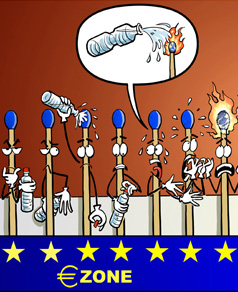Congratulations are in order for Estonia, and also perhaps condolences. The nation officially joined the euro zone on Jan. 1 — an impressive achievement, symbolic of the country’s transformation from former Soviet province to good European citizen.
But the cost of the adventure so far has included a Depression-level slump. Gross domestic product is growing again, but only after falling 18 percent since 2007. International Monetary Fund projections show Estonia’s G.D.P. failing to regain its 2007 level through 2015. Unemployment has also risen to almost 18 percent, and is expected to remain above 10 percent into 2014. So, congratulations to Estonia — but condolences, too. This wasn’t the glittering entrance to the euro you were promised years ago.
I must point out that Europe’s recent struggles with the common currency have somewhat vindicated the “euroskeptics” — all those people (me included) who had doubts about the euro project from the beginning.
So what prompted those doubts? Economists like myself and Barry Eichengreen assessed the proposed currency in terms of the optimum currency area theory, which basically says that there are both benefits and costs to two or more nations’ adopting a common currency.
The benefit is the reduced cost of doing business. The cost is that it’s harder to get prices back in line after “asymmetric shocks” — booms and slumps that affect some countries in a currency union but not others. That burden is reduced if labor is highly mobile between booming and slumping regions and if you have fiscal integration (a point made by Peter Kenen, my colleague at Princeton), so that the shock of a local slump is partly absorbed by lower tax payments to, and higher transfer payments from, a central government.
In the early 1990s a number of American economists evaluated the proposed euro by comparing Europe to the United States, which is the best example we have of a working, continent-sized currency area. And what they found was that Europe fell far short of the United States in terms of suitability — there was much less labor mobility and no fiscal integration to speak of. Supporters of the euro had expected very large trade gains, but the actual experience has been much more modest, failing to match the high hopes some had for the euro. So the academic euroskeptics have been proven right.
Now, that does not mean that the euro zone should break up — that would be highly disruptive. But there is a lesson here, namely that straightforward economic analysis has its virtues.
Euro enthusiasts dismissed the cost-benefit analyses performed by many economists. Yet those costs and benefits did, and do, matter.
Backstory: Euro Debate Resurfaces
Though Europe is struggling with a debt crisis and increasing public anxiety over the possibility of further bailouts, on New Year’s Day Estonia became the 17th member nation of the euro zone.
Let Truthout send our best stories to your inbox every day, for free.
Despite economic problems across the continent, officials in Estonia — which in 1992 pegged its kroon to the German mark and then to the euro — wouldn’t have it any other way. According to Jürgen Ligi, Estonia’s finance minister, “there is no alternative” to the euro. “This is the only boat in the sea.”
When most of Europe agreed to adopt a common currency in the 1990s, economists and politicians saw the euro as a way to ease trade among countries and smooth cross-border conflicts of interest.
But not everyone was convinced the euro would be a success, and as the sovereign debt crisis threatened to spread throughout Europe last year, many of the early debates over the euro’s viability returned to public discussion.
Critics of the European monetary union point out that previous currency projects in Europe have never worked. One reason, they say, is that the economies of poorer southern countries differ from those of wealthier northern countries, with their divergent fiscal policies, rates of inflation and levels of employment: one currency cannot possibly serve such disparate needs.
Other critics contend that the euro zone would need a unified tax-and-payment-transfer system, like that of the United States, in order for the common currency to work.
Proponents of the euro see the current situation simply as a temporary setback on the route to a more unified Europe. For them, the euro is a symbol of European solidarity and a tool for overcoming the types of conflicts that led to two world wars in the last century. What is needed to handle the current economic crisis, they say, is more political resolve.
© 2010 The New York Times Company
Truthout has licensed this content. It may not be reproduced by any other source and is not covered by our Creative Commons license.
Paul Krugman joined The New York Times in 1999 as a columnist on the Op-Ed page and continues as a professor of economics and international affairs at Princeton University. He was awarded the Nobel in economic science in 2008.
Mr Krugman is the author or editor of 20 books and more than 200 papers in professional journals and edited volumes, including “The Return of Depression Economics” (2008) and “The Conscience of a Liberal” (2007).
Copyright 2010 The New York Times.
All republished content that appears on Truthout has been obtained by permission or license.
Join us in defending the truth before it’s too late
The future of independent journalism is uncertain, and the consequences of losing it are too grave to ignore. To ensure Truthout remains safe, strong, and free, we need to raise $46,000 in the next 7 days. Every dollar raised goes directly toward the costs of producing news you can trust.
Please give what you can — because by supporting us with a tax-deductible donation, you’re not just preserving a source of news, you’re helping to safeguard what’s left of our democracy.
